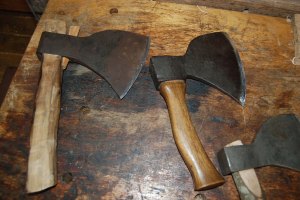I don't know any of the sciency stuff, but north American axes were designed to bite deep into the vast hardwoods found here and that to me makes them the best in the World.
From the giant sequoias here in California to the hickory forests in Tennessee...ect the axes used were designed for such trees and I don't think any other axe could get the job done.
Im sorry if you think I'm stubborn and ignorant ( nobody said that, but there's a lot that we don't post 😁 ) but I am a north American ( Canada is practically part of the us ) and will never change my mind
Best in the World in what? South America has great many species of trees that are even harder than those in North America, and despite that people continued to use poll-less axes there even in the 20th century.
Have you ever used poll-less axes? I have and can tell you that there are both well balanced poll-less axes and unbalanced ones. The same as with polled axes. Some of the polled hardware store axes you find in the US are very poorly balanced: despite the pronounced poll they are still blade heavy.
The trick is, that, as FortyTwoBlades said, it is not only the axe head itself, but also the handle, and the way it is hung what determines the actual balance.
In addition, some of the bearded axes with only a rudimentary poll I have used had a very thick and wide cheek section, which counterbalanced the weight of the bearded bit surprisingly well:
http://i.ebayimg.com/images/i/281552834756-0-1/s-l1000.jpg
http://i.ebayimg.com/images/g/fFQAAOSw-7RVGtLH/s-l1600.jpg
I am not saying that these type of axes are superior or equal to the American style polled axes, but it takes to actually use them to realize that they are not necessarily the completely unbalanced monstrosities they appear to be just based on their look.
Some of them are truly monstrosities and extremely poorly balanced though.

What is misleading is that the closest looking axes resembling these and which might be familiar to the North American axe users today are the hewing axes with their bearded design, which are poor for felling and splitting. Similarly, the tomahawks (descended from the Biscayan trade axes) look similar to the South American axes, but I am not sure if the balance of the typical contemporary tomahawk is necessarily representing the real balance of the South American or the traditional Italian axes.
Looks can be deceptive.
Look up please the Harz pattern Ochsenkopf Axe, a traditional regional German pattern. It has a minimal poll, yet it is well balanced.
I agree that the
well designed polled axes are very well balanced.
I also agree, that having a poll makes it easier to balance an axe when it is hung/rehung, since the balancing is achieved through the counterweight of the poll rather than the positioning of the handle.
But that does not mean that all polled axes are well balanced just because they have polls, or that all poll-less axes are poorly balanced just because they lack polls.
I dont think you are ignorant and it is also possible, that you may yet to change your mind.

And this does not require that you should buy or even recommend poll-less axes.

Finally, I also prefer the American polled axe
because it still feels so
exotic and exciting to me.

(I grew up with mostly poll-less axes.)









